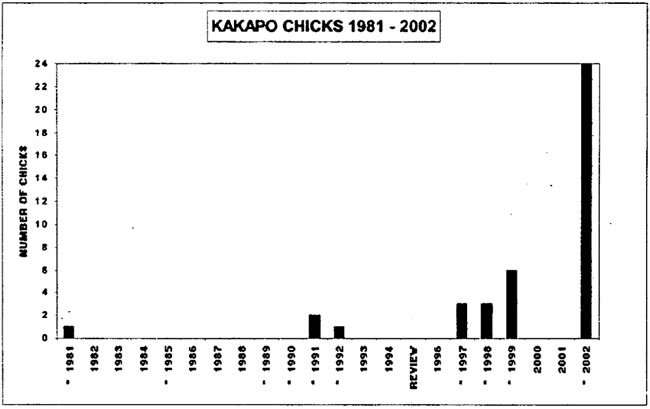Abstract
The kakapo (Strigops habroptilus) is a large (1.5–3.0 kg) nocturnal, flightless, lek-breeding parrot endemic to New Zealand. Its distribution was once widespread, but the arrival of humans 600–800 yr ago impacted the kakapo population. Reduction of numbers was caused by hunting, habitat destruction and the introduction of predators such as kiore (Polynesian rats) and dogs by the Maori and other species of rats, cats and mustelids by Europeans in the 1800s and 1900s.
In the late 1960s, only a few males were found in remote areas of the Fiordland Mountains. In 1981 the first female kakapo were identified in a re-discovered population of 200 birds on Stewart Island, a large island to the south of the mainland. The relief was short lived because feral cats were decimating the population and cat control measures were ineffective at halting the decline. Kakapo were transferred to smaller islands, which were either predator free or had only kiore present. Kiore were not suspected to be a problem for kakapo until almost 10 yr later. Monitoring nests discovered kiore preying upon newly hatched chicks when the females left the nest to feed at night. Kakapo and other native avian species were temporarily removed from island preserves and sodium monofluoroacetate pellets (commonly called "1080") were air-dropped to eliminate mammalian predators.
Over the next 15 yr there was no significant increase in the population (50 individuals) under a hands-off management system. In 1995, a review of the Kakapo Recovery Program led to an intensive population management approach. A multidisciplinary management team was organized to direct the recovery program composed of technical officer, team leader, scientist, and an aviculturist and in 2000 a veterinary position was added. Techniques were introduced to increase productivity. Radio transmitters were placed on all birds to facilitate finding nests. An infrared camera was used to monitor nest activity and linked to a video recorder, which continually taped activity inside the nest. It was also linked to a video screen, which two staff members watch each night. The radio transmitters permit close monitoring of adult kakapo to minimize morbidity and mortality. Specialized radio receivers with data logger and memory storage record the movements of birds within a 10-m radius. It is useful at breeding times to monitor which females visit the track and bowl areas of males. When placed next to a feeding station, it is linked to a set of electronic scales to record which birds are feeding at which stations and their body weights.
Supplementary feeding of nuts, fruit and vegetables was initially used in an attempt to increase the frequency of breeding in the early 1990s but the results were equivocal and may have led to obesity-related problems. Natural food items consumed by kakapo were identified. A palatable balanced organic kakapo pellet was developed as a feeding supplement.
Annual health assessments are completed for every bird. Plasma chemistry panels, CBC and bacterial/fungal swabs are collected to establish baseline normal values and allow detection of alterations. During the 2002 breeding season, blood and microbiology samples were collected at least twice from all 24 chicks to establish baseline normal values. Candida famata was cultured from the crops of slow-growing chicks and was not found in the crops of chicks with steady body weight increases. The significance of this novel yeast is still under investigation; is it a newly emerging primary pathogen or is it secondary to altered crop motility? Electroejaculation techniques were developed for semen collection from free-ranging kakapo to investigate problems with perceived male infertility. There are no previously published accounts of electroejaculation techniques used to study free-ranging psittacines. In a preliminary study at the end of the 2002 breeding season, sperm was collected and examined from 12/13 anesthetized sexually mature male kakapo. In January 2003, electroejaculation was the first indicator that no male birds were producing sperm and that a breeding season for 2003 was unlikely.
In conclusion, the change in management and a multidisciplinary approach has had a significant impact on the success of the Kakapo Recovery Program. Thirty-six kakapo chicks have successfully fledged, representing 72% increase in the population (Figure 1). These successes demonstrate the effectiveness of intensive population management with veterinary assistance.
Figure 1. Bar graph demonstrating the annual production from 1981–2002 of chicks (n=36) from free-ranging Kakapo
